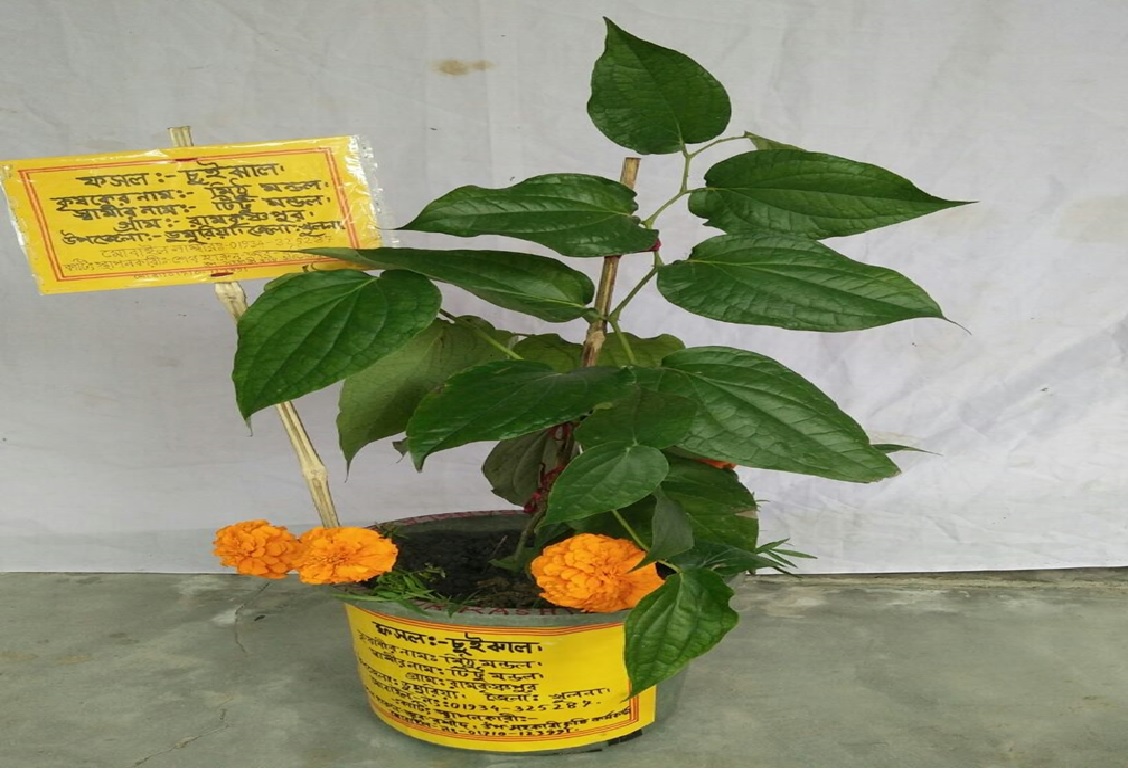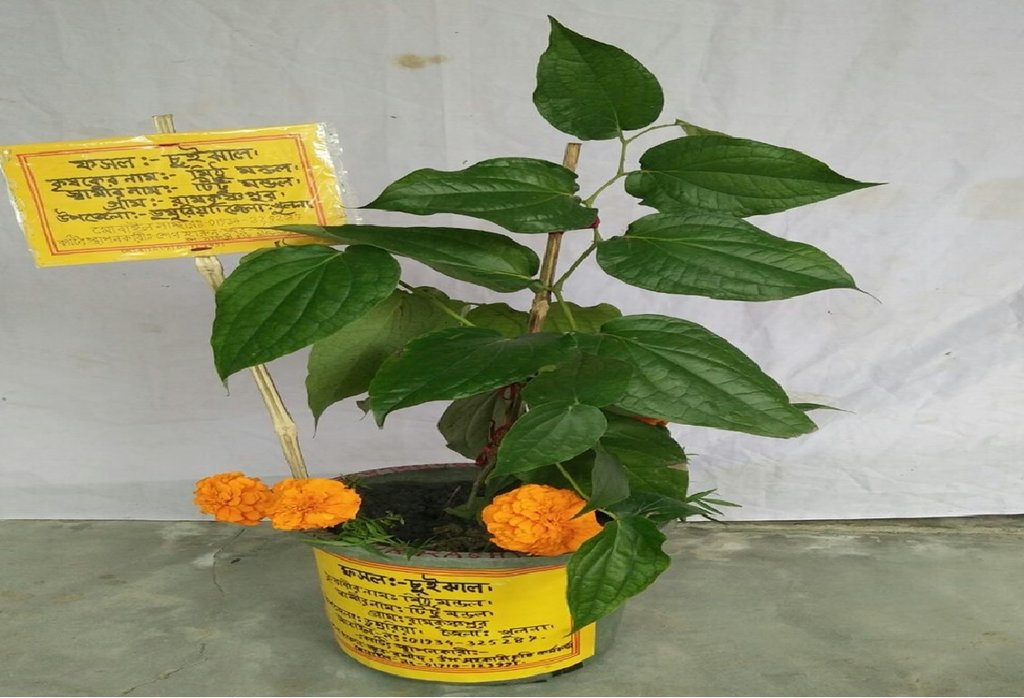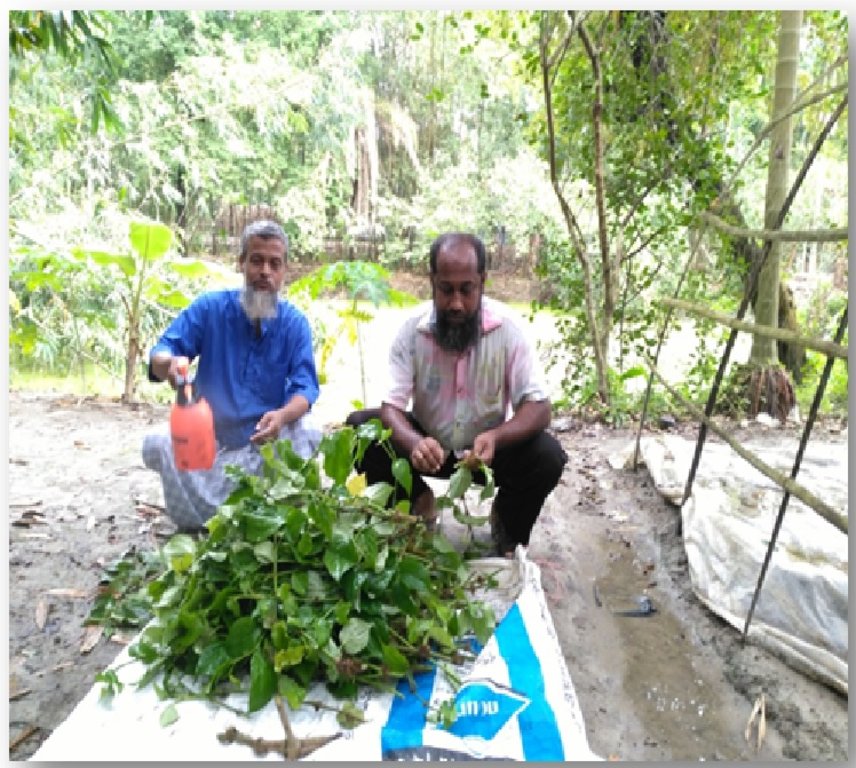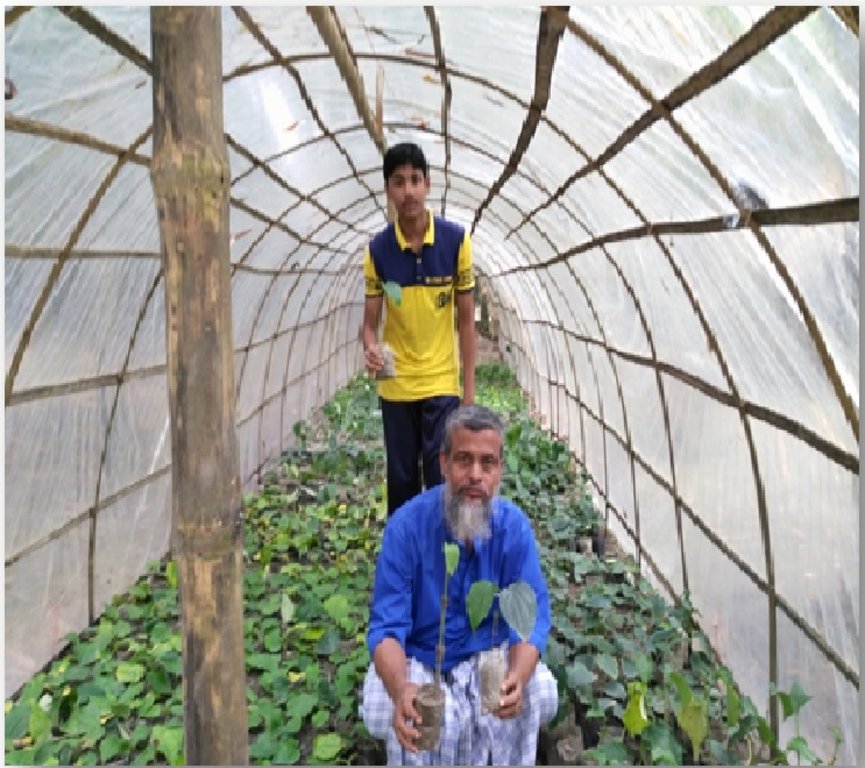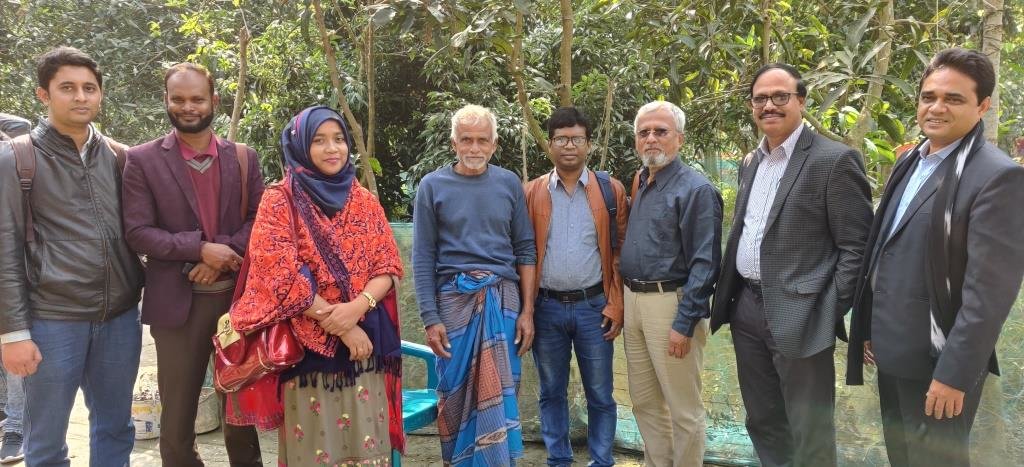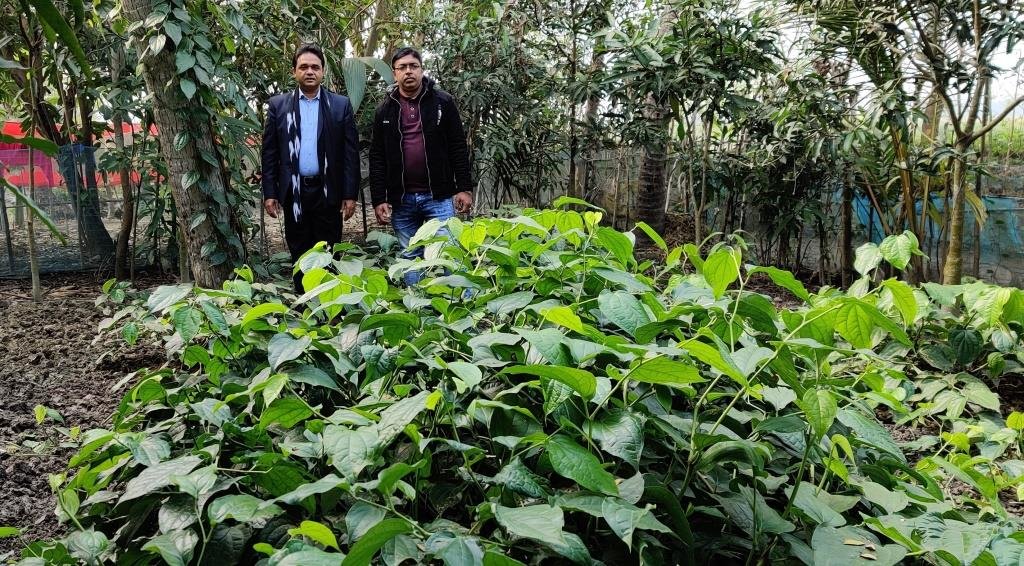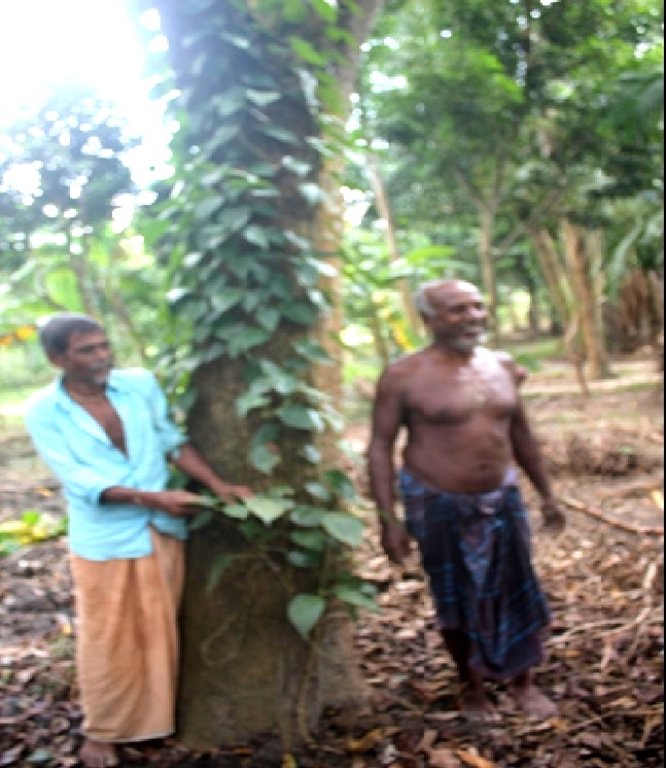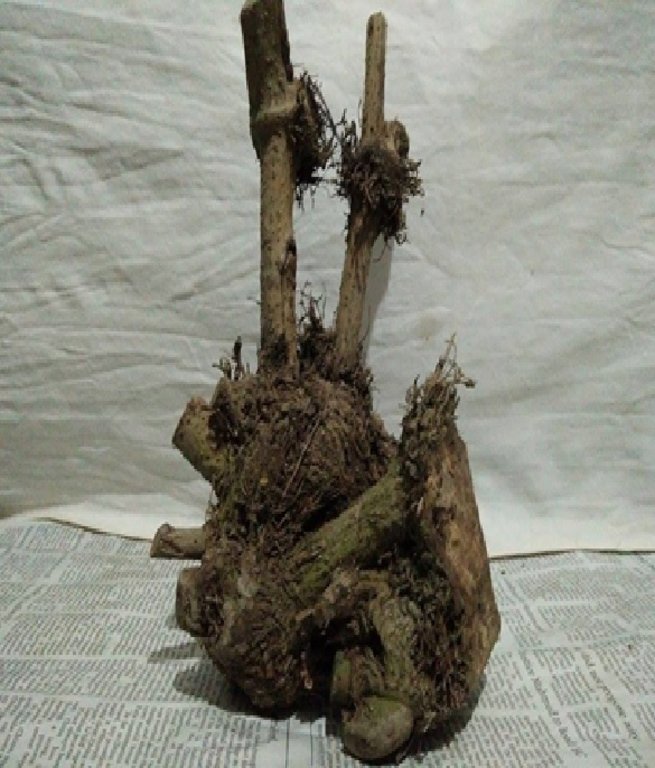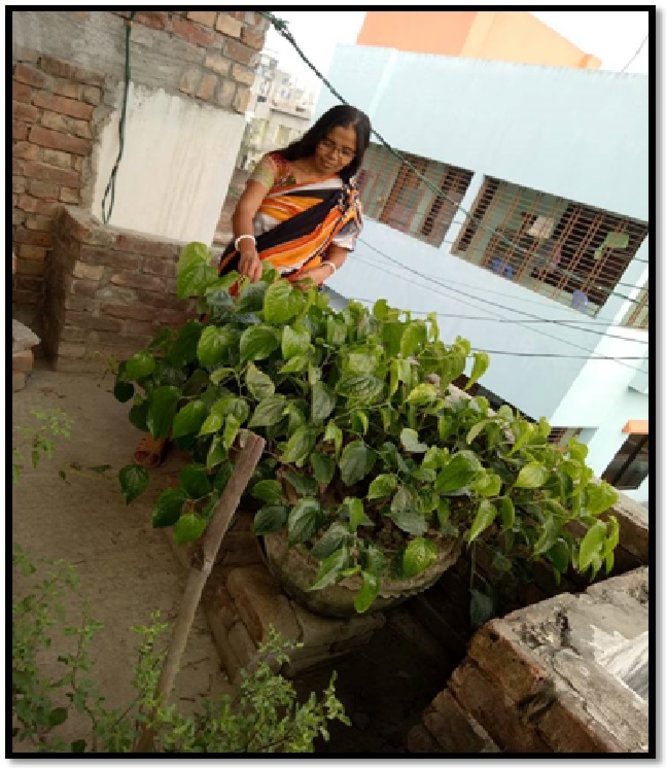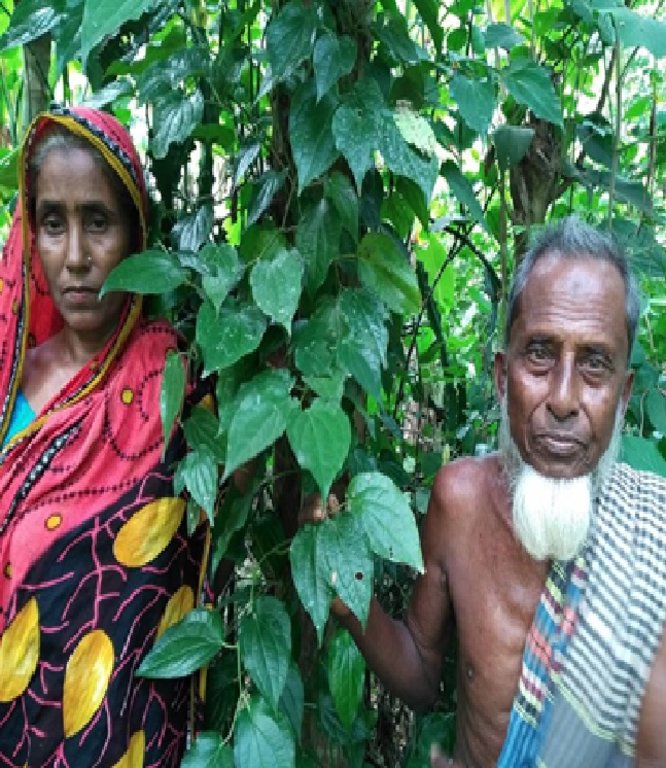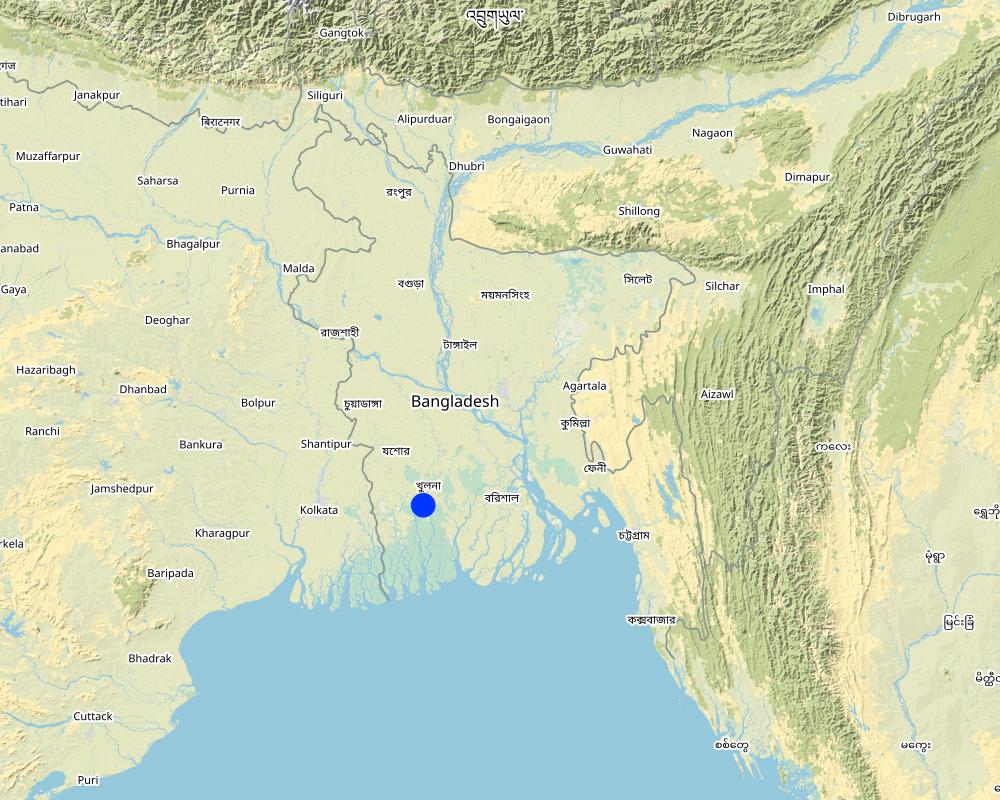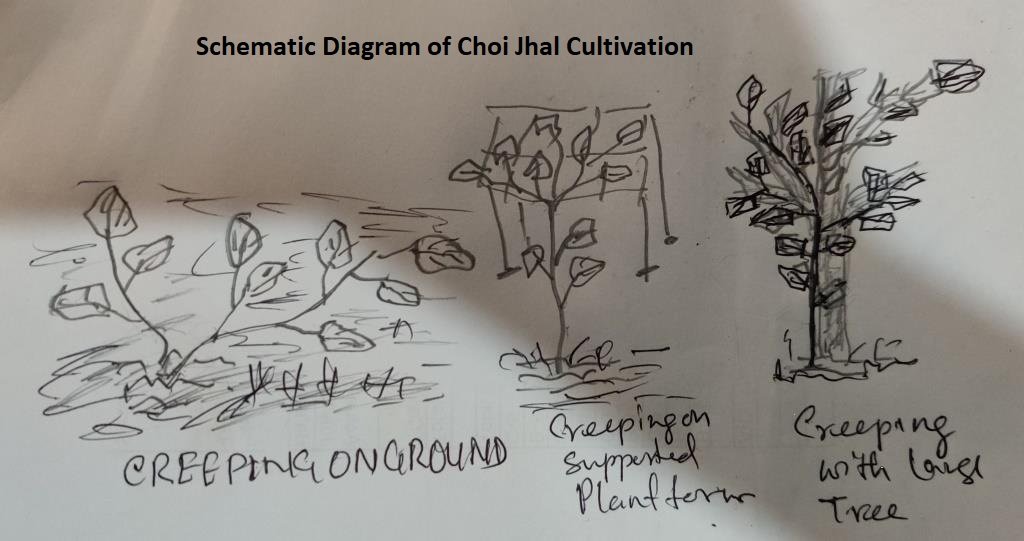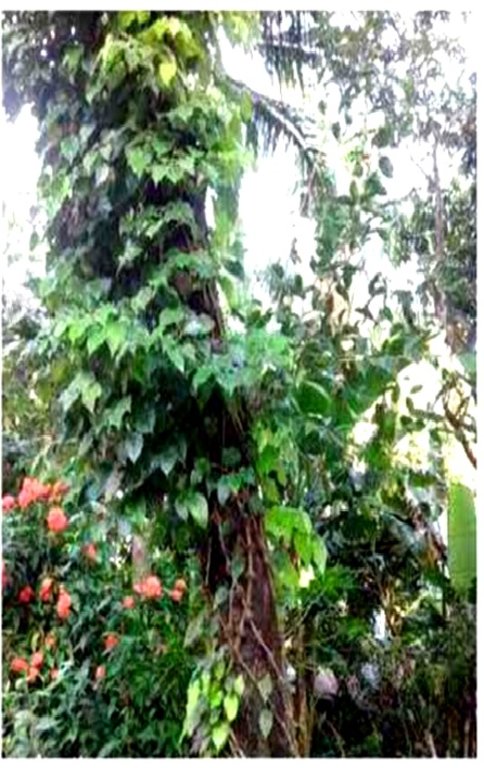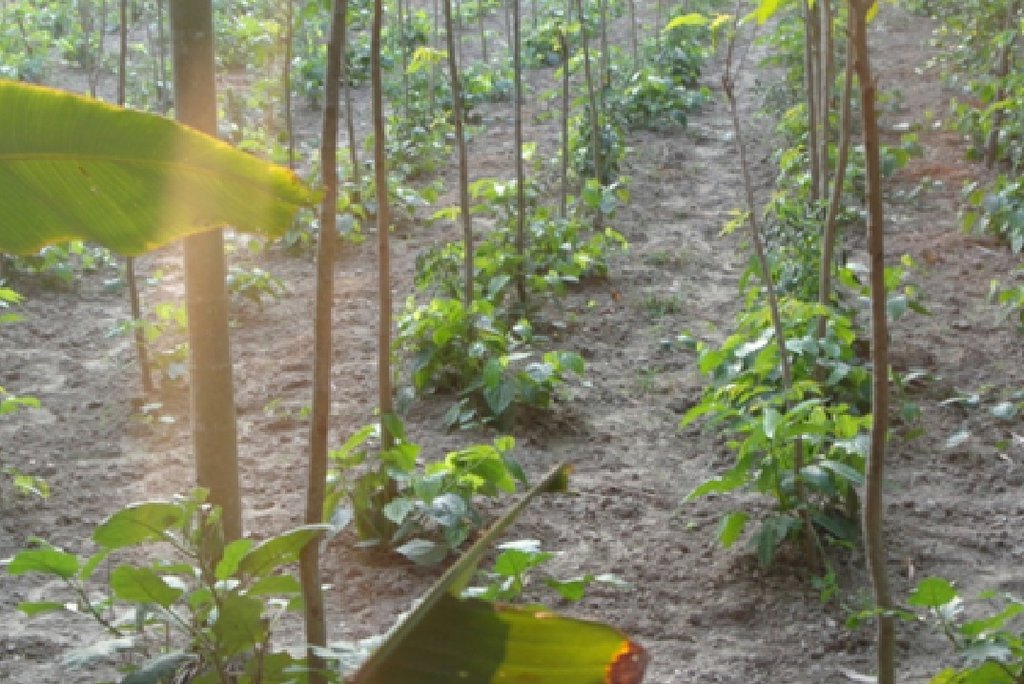Choi cultivation- a profitable crop for saline areas of Bangladesh [孟加拉国]
- 创建:
- 更新:
- 编制者: Jalal Uddin Md. Shoaib
- 编辑者: –
- 审查者: Rima Mekdaschi Studer, William Critchley
Morich lota chash
technologies_5769 - 孟加拉国
查看章节
全部展开 全部收起1. 一般信息
1.2 参与该技术评估和文件编制的资源人员和机构的联系方式
关键资源人
co-compiler:
Islam Nazrul
Department of Agricultural Extension, Khulna
孟加拉国
有助于对技术进行记录/评估的项目名称(如相关)
Establishing National Land Use and Land Degradation Profile toward Mainstreaming SLM Practices in Sector Policies (ENALULDEP/SLM)1.3 关于使用通过WOCAT记录的数据的条件
编制者和关键资源人员接受有关使用通过WOCAT记录数据的条件。:
是
1.4 所述技术的可持续性声明
这里所描述的技术在土地退化方面是否存在问题,导致无法被认为是一种可持续的土地管理技术?:
否
2. SLM技术的说明
2.1 技术简介
技术定义:
Choi Jhal (Piper chaba), locally called morich lota is a creeping vine that is grown in homesteads of saline areas. It is adapted to soil salinity, grows under shade and is a very high value crop. It remains green throughout the year, reducing evapotranspiration from the soil and hence reduces capillary rise of salinity from shallow ground water.
2.2 技术的详细说明
说明:
Choi Jhal (Piper chaba), locally called morich lota is a creeping vine that is grown in homesteads of saline areas. It is adapted to soil salinity, grows under shade and is a very high value crop. It remains green throughout the year, reducing evapotranspiration from the soil and hence reduces capillary rise of salinity from shallow ground water. Choi Jhal locally called morich lota, is one of the most popular and unique spices in the south-western region of Bangladesh. It is a flowering vine grown in southern-western districts like Khulna and Satkhira. There are two types of choi found in these areas. One is a narrow vine (20 - 25 mm diameter) and the other is about 2. 5 - 5 cm in diameter. It creeps up to 8-10 meters when allowed to extend on ground. On the other hand it also climb up large trees like Mango (Mangifera indica), Jam (Syzygium cumini), Betel nut (Areca catechu), Coconut (Cocos nucifera) and Kafula (Lannea coromandelica), etc. Leaves and stems of the choi vine look like betel leafs (local name Paan; scientific name: Piper betle). Betel and choi are two species of the same family, Piperaceae. The leaves of choi are oval-shaped and about 5-6 cm long. The flowers are monoecious and blossom during the monsoon. The fruit looks similar to other varieties of long pepper, with an elongated shape that can grow up to 6 cm inches long. The fruit is red when ripe, and turns dark brown or black when dry. Chopped parts of the plant are cooked them with meat and fish, especially with mutton. The spicy pungent flavor of Choi Jhal is a year-round additive spice. In Thailand, P. chaba is known commonly as "Dee Plee”.
This technology was documented as one of the best practices that supports improved livelihoods of farmers who have no, or very little, cultivable land except their home yards. It is adapted to seasonal salinity in the dry season and waterlogging in monsoon. Pankhali is a village of Dacop Upazalia, Khulna where most of farmer practiced choi cultivation as their main income source. It is easy to propagate with cuttings of vines ideally of 50-75 cm with at least 4-5 nodes. Generally no chemical fertilizer is used for its cultivation, rather domestic waste or compost is used in ‘pits’ at the time of planting vine cuttings. The cuttings of vines are planted in April-May or November-December in relatively higher areas of the home gardens, with loamy soils. Choi is shade-loving. Approximately 2-2.5 ton/ha could be harvested after 5-6 years. It could be harvested after one year, but ideally it is better to harvest after 5 years. Farmers earn 1,000-1,500 BDT (US$1= 84 BDT) per kg from 5-year old choi. The mature roots are more valuable than the green vine. These days this product is marketed by many departmental stores of the city.
This expensive spice has great medicinal value, and tastes like pepper. It has been used to treat different kinds of diseases and it has a number of herbal uses, specially the antimicrobial and antioxidant active ingredients, Choi has 7% aromatic oil, 5% alkoloid and pepertin and in roots 13-15% peperin. The people of the area believe that it helps to remedy various diseases. One inch of choi can be used as medication for coughs. Its price depends on its thickness, and different thicknesses of Piper chaba taste different. Thicker ones are popular for its flesh and thinner ones for their spicy heat.
Commonly the twigs, stems or roots both fresh and dried forms are used in this area as a spice. Sometimes it is ground and used as an ingredient in a variety of sauces and pastes. It is a relatively expensive spice and the roots are usually more expensive than the stems because of their stronger aroma. It is mainly used as a taste enhancer. It makes the food spicier. It is also used in Jhalmori, Pickles, Halim and for making tasty soups.
2.3 技术照片
2.5 已应用该技术的、本评估所涵盖的国家/地区/地点
国家:
孟加拉国
有关地点的进一步说明:
It is spread over most of the districts of Khulna division
具体说明该技术的分布:
- 均匀地分布在一个区域
如果不知道精确的区域,请注明大致覆盖的区域:
- 10-100 平方千米
技术现场是否位于永久保护区?:
否
注释:
Choi Jhal is grown in most of the homesteads as a valuable crop.
Map
×2.6 实施日期
如果不知道确切的年份,请说明大概的日期:
- 10-50年前
2.7 技术介绍
详细说明该技术是如何引入的:
- 通过土地使用者的创新
- 作为传统系统的一部分(> 50 年)
3. SLM技术的分类
3.1 该技术的主要目的
- 改良生产
- 减少、预防、恢复土地退化
- 创造有益的经济影响
- cover crop when allowed to creep on ground
3.2 应用该技术的当前土地利用类型
同一土地单元内混合使用的土地::
否

农田
- 多年一作(非木材)
多年生(非木质)作物 - 指定作物:
- herbs, chili, capsicum

其它
具体说明:
Homestead area
注释:
A small part of homesteads are used to grow Choi Jhal or it is planted near a larger tree like Mango, Kafula ( Lenea coromondalica), coconut etc. It is a shade-loving crop. Therefore homesteads are best for this crop.
3.3 由于技术的实施,土地使用是否发生了变化?
由于技术的实施,土地使用是否发生了变化?:
- 否(继续问题3.4)

其它
具体说明:
Homestead areas
3.4 供水
该技术所应用土地的供水:
- 混合雨水灌溉
注释:
It may require occasional irrigation at the initial stage
3.5 该技术所属的SLM组
- 家庭花园
3.6 包含该技术的可持续土地管理措施

农艺措施
- A1:植被和土壤覆盖层
- A2:有机质/土壤肥力
3.7 该技术强调的主要土地退化类型

化学性土壤退化
- Cs:盐化/碱化

其它
具体说明:
It helps to reduce soil salinity
3.8 防止、减少或恢复土地退化
具体数量名该技术与土地退化有关的目标:
- 不适用
4. 技术规范、实施活动、投入和成本
4.1 该技术的技术图纸
技术规范(与技术图纸相关):
Choi Jhal (Piper chaba) vines are generally grown as farmers choice, where they are mainly allowed to creep along the ground or allowed to creep up large trees like Mango, Kafula, Coconut etc. Vines are planted in small pits filled with kitchen waste or compost. Vines generally are 50-75 cm with 4-5 nodes.
作者:
jalal Uddin Md. Shoaib
日期:
07/01/2020
技术规范(与技术图纸相关):
Choi Jhal Creeping with stick to climb on platform
作者:
jalal Uddin Md. Shoaib
日期:
07/01/2020
4.2 有关投入和成本计算的一般信息
具体说明成本和投入是如何计算的:
- 每个技术区域
注明尺寸和面积单位:
approximately 0.01ha
其它/国家货币(具体说明):
BDT
如相关,注明美元与当地货币的汇率(例如1美元=79.9巴西雷亚尔):1美元=:
84.95
注明雇用劳工的每日平均工资成本:
500
4.3 技术建立活动
| 活动 | 时间(季度) | |
|---|---|---|
| 1. | Bed or PIT preparation | April-May, Nov-Dec |
| 2. | Planting | April-May, Nov-Dec |
4.4 技术建立所需要的费用和投入
| 对投入进行具体说明 | 单位 | 数量 | 单位成本 | 每项投入的总成本 | 土地使用者承担的成本% | |
|---|---|---|---|---|---|---|
| 劳动力 | Labour | 1 | 4.0 | 500.0 | 2000.0 | 100.0 |
| 植物材料 | Cuttings/ vine of Choi (Own produce) | 1 | 20.0 | 10.0 | 200.0 | |
| 肥料和杀菌剂 | Compost (Own) | LS | 1.0 | 50.0 | 50.0 | |
| 技术建立所需总成本 | 2250.0 | |||||
| 技术建立总成本,美元 | 26.49 | |||||
如果您无法分解上表中的成本,请估算建立该技术所需要的总成本。:
2250.0
如果土地使用者负担的费用少于100%,请注明由谁负担其余费用:
100%
4.5 维护/经常性活动
| 活动 | 时间/频率 | |
|---|---|---|
| 1. | Watch and ward | as necessary |
4.6 维护/经常性活动所需要的费用和投入(每年)
如果您无法分解上表中的成本,请估算维护该技术所需要的总成本。:
500.0
如果土地使用者负担的费用少于100%,请注明由谁负担其余费用:
100%
注释:
It is very easy to maintain. Only to look after the crop while creeping.
4.7 影响成本的最重要因素
描述影响成本的最决定性因素:
not applicable
5. 自然和人文环境
5.1 气候
年降雨量
- < 250毫米
- 251-500毫米
- 501-750毫米
- 751-1,000毫米
- 1,001-1,500毫米
- 1,501-2,000毫米
- 2,001-3,000毫米
- 3,001-4,000毫米
- > 4,000毫米
农业气候带
- 半湿润
5.2 地形
平均坡度:
- 水平(0-2%)
- 缓降(3-5%)
- 平缓(6-10%)
- 滚坡(11-15%)
- 崎岖(16-30%)
- 陡峭(31-60%)
- 非常陡峭(>60%)
地形:
- 高原/平原
- 山脊
- 山坡
- 山地斜坡
- 麓坡
- 谷底
垂直分布带:
- 0-100 m a.s.l.
- 101-500 m a.s.l.
- 501-1,000 m a.s.l.
- 1,001-1,500 m a.s.l.
- 1,501-2,000 m a.s.l.
- 2,001-2,500 m a.s.l.
- 2,501-3,000 m a.s.l.
- 3,001-4,000 m a.s.l.
- > 4,000 m a.s.l.
说明该技术是否专门应用于:
- 不相关
5.3 土壤
平均土层深度:
- 非常浅(0-20厘米)
- 浅(21-50厘米)
- 中等深度(51-80厘米)
- 深(81-120厘米)
- 非常深(> 120厘米)
土壤质地(表土):
- 中粒(壤土、粉土)
土壤质地(地表以下> 20厘米):
- 中粒(壤土、粉土)
表土有机质:
- 高(>3%)
5.4 水资源可用性和质量
地下水位表:
5-50米
地表水的可用性:
中等
水质(未处理):
不可用
水质请参考::
地表水
水的盐度有问题吗?:
是
该区域正在发生洪水吗?:
否
5.5 生物多样性
物种多样性:
- 高
栖息地多样性:
- 高
5.6 应用该技术的土地使用者的特征
定栖或游牧:
- 定栖的
生产系统的市场定位:
- 混合(生计/商业)
非农收入:
- 低于全部收入的10%
相对财富水平:
- 贫瘠
- 平均水平
个人或集体:
- 个人/家庭
机械化水平:
- 手工作业
性别:
- 女人
- 男人
土地使用者的年龄:
- 中年人
- 老年人
5.7 应用该技术的土地使用者使用的平均土地面积
- < 0.5 公顷
- 0.5-1 公顷
- 1-2 公顷
- 2-5公顷
- 5-15公顷
- 15-50公顷
- 50-100公顷
- 100-500公顷
- 500-1,000公顷
- 1,000-10,000公顷
- > 10,000公顷
这被认为是小规模、中规模还是大规模的(参照当地实际情况)?:
- 小规模的
5.8 土地所有权、土地使用权和水使用权
土地所有权:
- 个人,有命名
土地使用权:
- 自由进入(无组织)
- 个人
用水权:
- 自由进入(无组织)
土地使用权是否基于传统的法律制度?:
是
5.9 进入服务和基础设施的通道
健康:
- 贫瘠
- 适度的
- 好
教育:
- 贫瘠
- 适度的
- 好
技术援助:
- 贫瘠
- 适度的
- 好
就业(例如非农):
- 贫瘠
- 适度的
- 好
市场:
- 贫瘠
- 适度的
- 好
能源:
- 贫瘠
- 适度的
- 好
道路和交通:
- 贫瘠
- 适度的
- 好
饮用水和卫生设施:
- 贫瘠
- 适度的
- 好
金融服务:
- 贫瘠
- 适度的
- 好
6. 影响和结论性说明
6.1 该技术的现场影响
社会经济效应
收入和成本
农业收入
注释/具体说明:
Home yards could be used to grow Choi with other crops/vegetables.
其它社会经济效应
Adopt seasonal salinity in dry seaspm and some what water logging in monsoon; a high value crop that increased cash income.
注释/具体说明:
The coastal area is saline in dry season and water logging in monsoon restricts cropping through out the year. Choi is a high value spice crop, could be grown in small areas of homesteads with other crops like vegetables etc. Small farmers of the area use this crop to earn cash.
对现场影响的评估(测量)进行具体说明:
Not applicable
6.2 该技术的场外影响已经显现
对场外影响(测量)的评估进行具体说明:
Not applicable
6.3 技术对渐变气候以及与气候相关的极端情况/灾害的暴露和敏感性(土地使用者认为的极端情况/灾害)
注释:
Not applicable
6.4 成本效益分析
技术收益与技术建立成本相比如何(从土地使用者的角度看)?
短期回报:
积极
长期回报:
非常积极
技术收益与技术维护成本/经常性成本相比如何(从土地使用者的角度看)?
短期回报:
非常积极
长期回报:
非常积极
6.5 技术采用
- > 50%
如若可行,进行量化(住户数量和/或覆盖面积):
Many of the homesteads already used to growing choi jahl
在所有采用这项技术的人当中,有多少人是自发的,即未获得任何物质奖励/付款?:
- 91-100%
6.6 适应
最近是否对该技术进行了修改以适应不断变化的条件?:
是
其它(具体说明):
At present nursery has been emerging to market saplings of choi jhalet
具体说明技术的适应性(设计、材料/品种等):
Nursery has been developed
6.7 该技术的优点/长处/机会
| 土地使用者眼中的长处/优势/机会 |
|---|
| Can earn cash money |
| Can use for own family |
| Can be grown in small area in homesteads |
| Almost all parts of the Choi Jhal are edible |
| 编制者或其他关键资源人员认为的长处/优势/机会 |
|---|
| Easy to propagate |
| No use of chemical fertilizer |
| Marketing of the crop increased |
| Added menu of restaurants bigger cities |
6.8 技术的弱点/缺点/风险及其克服方法
| 土地使用者认为的弱点/缺点/风险 | 如何克服它们? |
|---|---|
| Fungus infection at early stage | Use of anti fungus |
| 编制者或其他关键资源人员认为的弱点/缺点/风险 | 如何克服它们? |
|---|---|
| Confined in Khulna division | Extension message could be developed |
| Preservation of green Choi | Harvesting matured parts or has to be market quickly. |
7. 参考和链接
7.1 信息的方法/来源
- 实地考察、实地调查
10 homesteads
- 与土地使用者的访谈
10
- 与SLM专业人员/专家的访谈
2
- 根据报告和其他现有文档进行编译
4
(现场)数据是什么时候汇编的?:
07/01/2020
7.3 链接到网络上的相关信息
标题/说明:
Choi Jhal: The culinary fire of Bengal
URL:
https://www.dhakatribune.com/bangladesh/nation/2020/01/09/choi-jhal-the-culinary-fire-of-bengal
标题/说明:
Chui Jhal is a traditional Khulna's spice that brings water to the tongue
URL:
https://www.orchidshade.com/2020/09/chui-jhal-is-traditional-khulna-spice.html
标题/说明:
Piper chaba
URL:
https://en.wikipedia.org/wiki/Piper_chaba
7.4 一般注释
The crop can be grown in small home gardens especially on higher ground. It is adapted to soil salinity, grows under shade and is a very high value crop. It remains green throughout the year, reducing evapotranspiration from the soil and hence reduces capillary rise of salinity from shallow ground water.
链接和模块
全部展开 全部收起链接
无链接
模块
无模块


